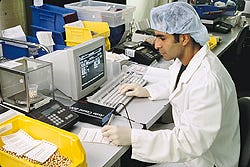July 1, 1997
Casebook
Counting Scales Aid Production
of Endoscopic Instruments
Provide quick and accurate part counts

Endoscopic surgery demands precision and accuracy. Not surprisingly, these same qualities are required by manufacturers that supply the devices used in this minimally invasive procedure. Boston Scientific/Symbiosis (Miami) manufactures a variety of such devices, including subassemblies for stent-delivery systems, needles, and biopsy forceps. During assembly, every component has to be cleaned, counted, and bagged before being delivered to the manufacturing floor. "We are dealing with thousands of tiny parts," explains Mike Voss, business unit manager for OEM products at Boston Scientific/Symbiosis. "It is crucial that we know the exact quantity."
To help determine the exact quantity of springs, screws, tubing, and other components, the company selected the Series C and CP high-precision counting scales from Setra Systems Inc. (Boxborough, MA). Both models are interfaced with Setra's Auto Count accessory for bar code scanning and label printing. Using Setra's patented variable capacitance technology, these scales offer counting resolution as fine as one part in 750,000.
When Boston Scientific/Symbiosis counts a piece for the first time, the average piece weight (APW) is determined through a sampling process. The scale prompts the operator to count 50 pieces onto the scale pan and press a key. The scale then determines how much one piece weighs, based on the weight of the entire sample. Once calculated, the APW is printed on a bar code label through Auto Count via the RS-232 communication port of the scale. This label is kept on a chart located above the scales.
The APW can also be input at the time of counting. If a bar code label exists for a particular part, the APW is simply scanned into the scale. "We count the same type of parts over and over. It is a great benefit to be able to scan the bar code and have the APW automatically entered into the scale. We are able to count quickly and accurately," says Voss.
Another bar code is placed on the bag of counted parts along with the drawing number and quantity. The bag is then stored in a bin until the parts are ready to be used for assembly. The bin is also labeled with a bar code and additional pertinent information to ensure proper part identification. When a work order comes in for 500 biopsy forceps, assembly personnel can go to the correct bin and take a bag containing the necessary quantity of parts.
According to Voss, the scales are providing a count accuracy of better than 99%. Voss concludes, "In the medical equipment field, time is an issue. It is crucial that we manufacture the parts quickly so our customers can provide the equipment to their clients. The Setra scales have streamlined our operation through quick and accurate counting."
For more information, call Setra Systems Inc. at 800/257-3872.
You May Also Like


